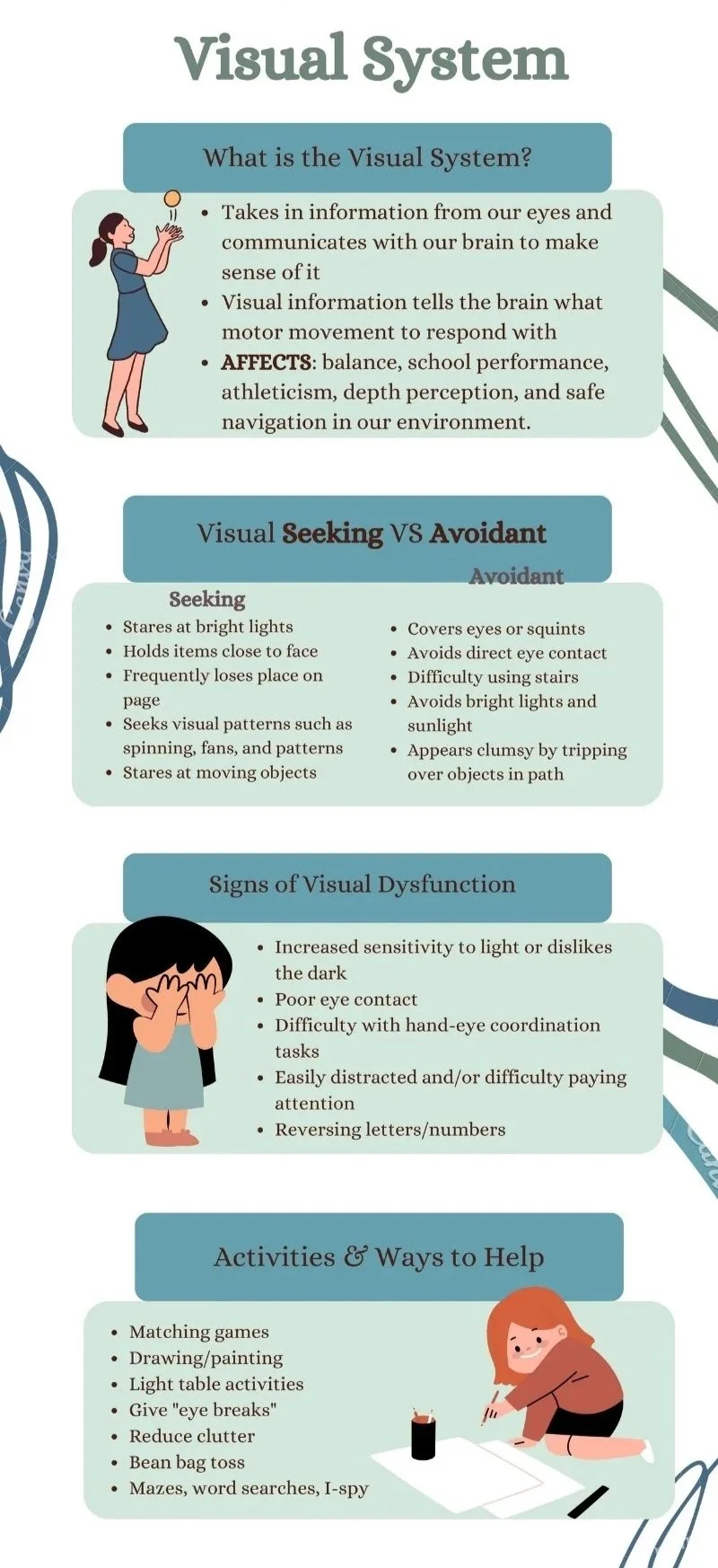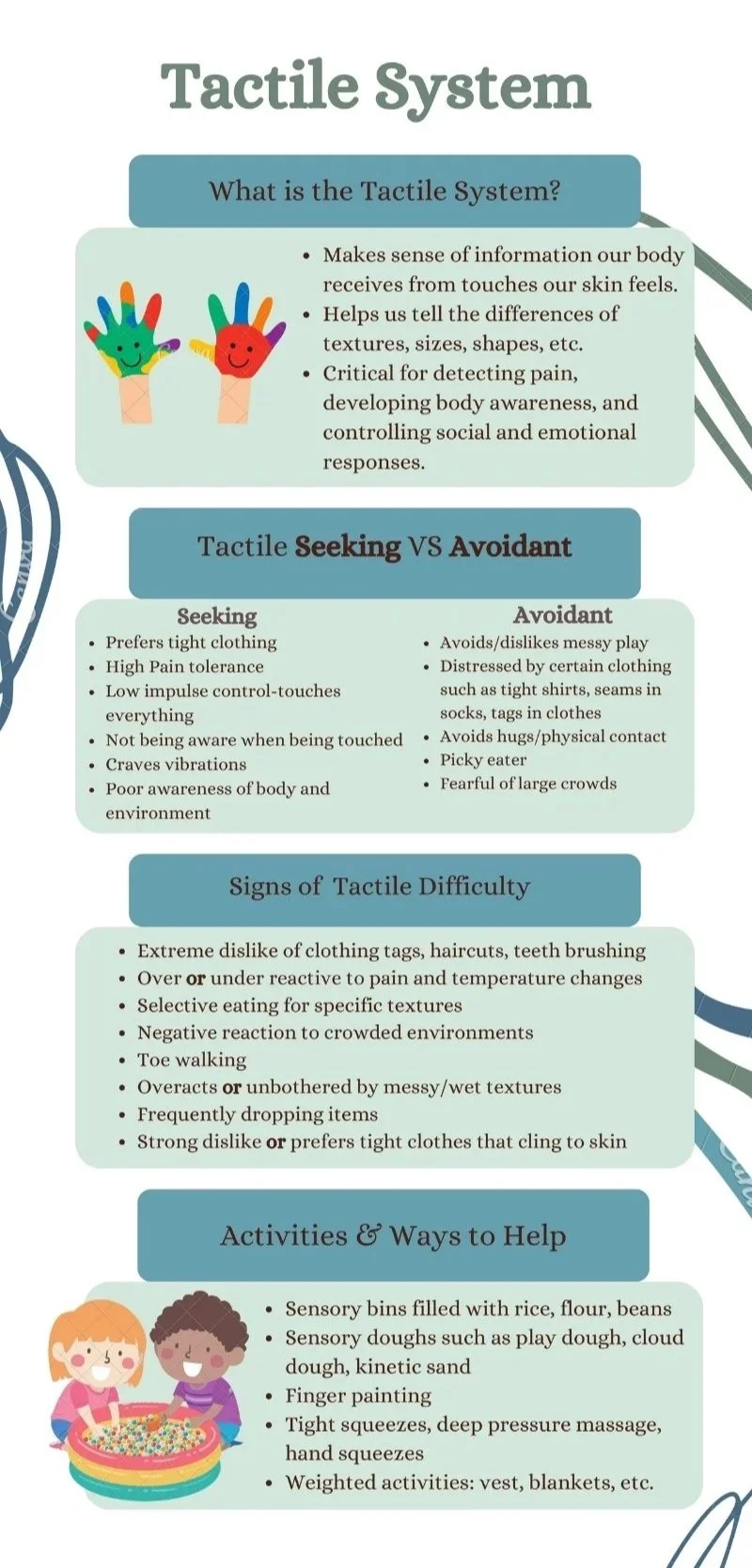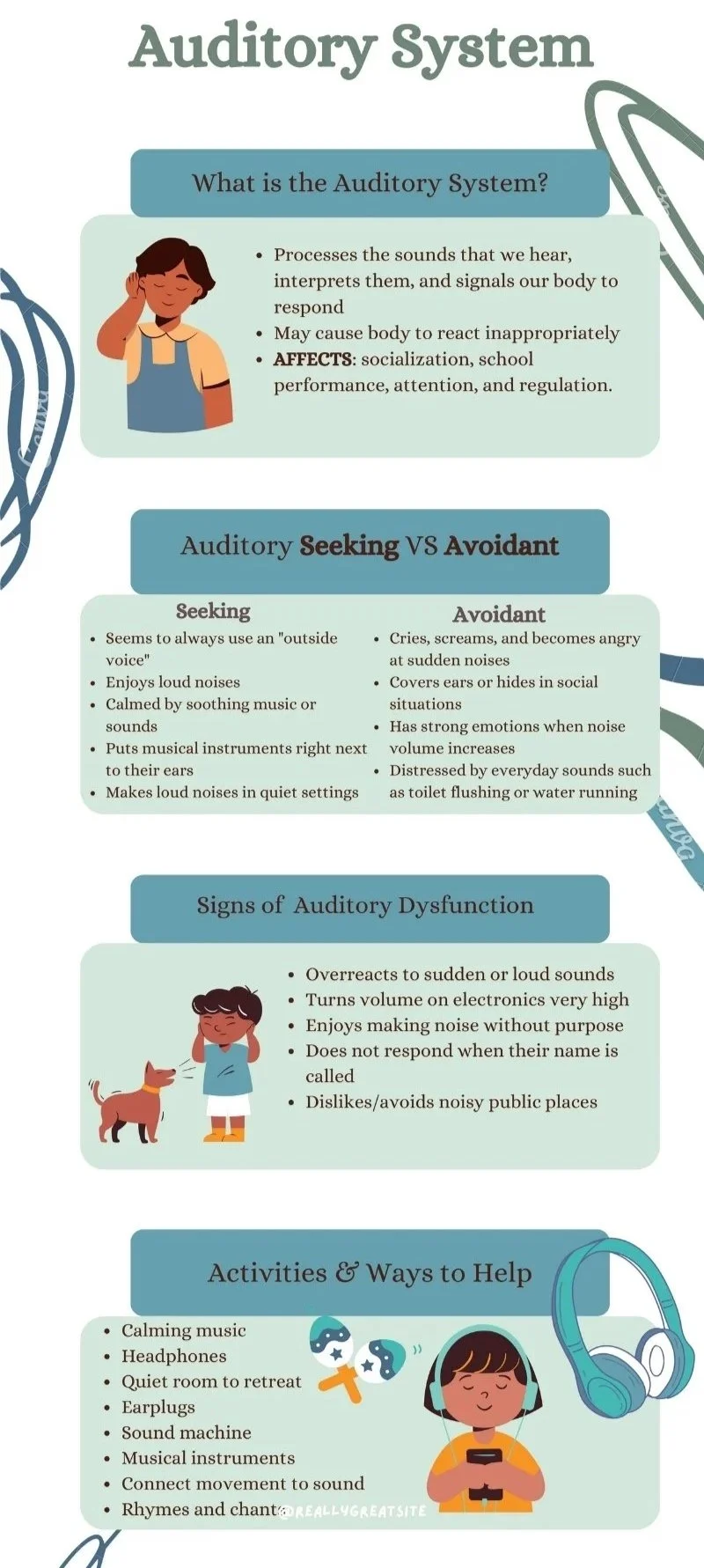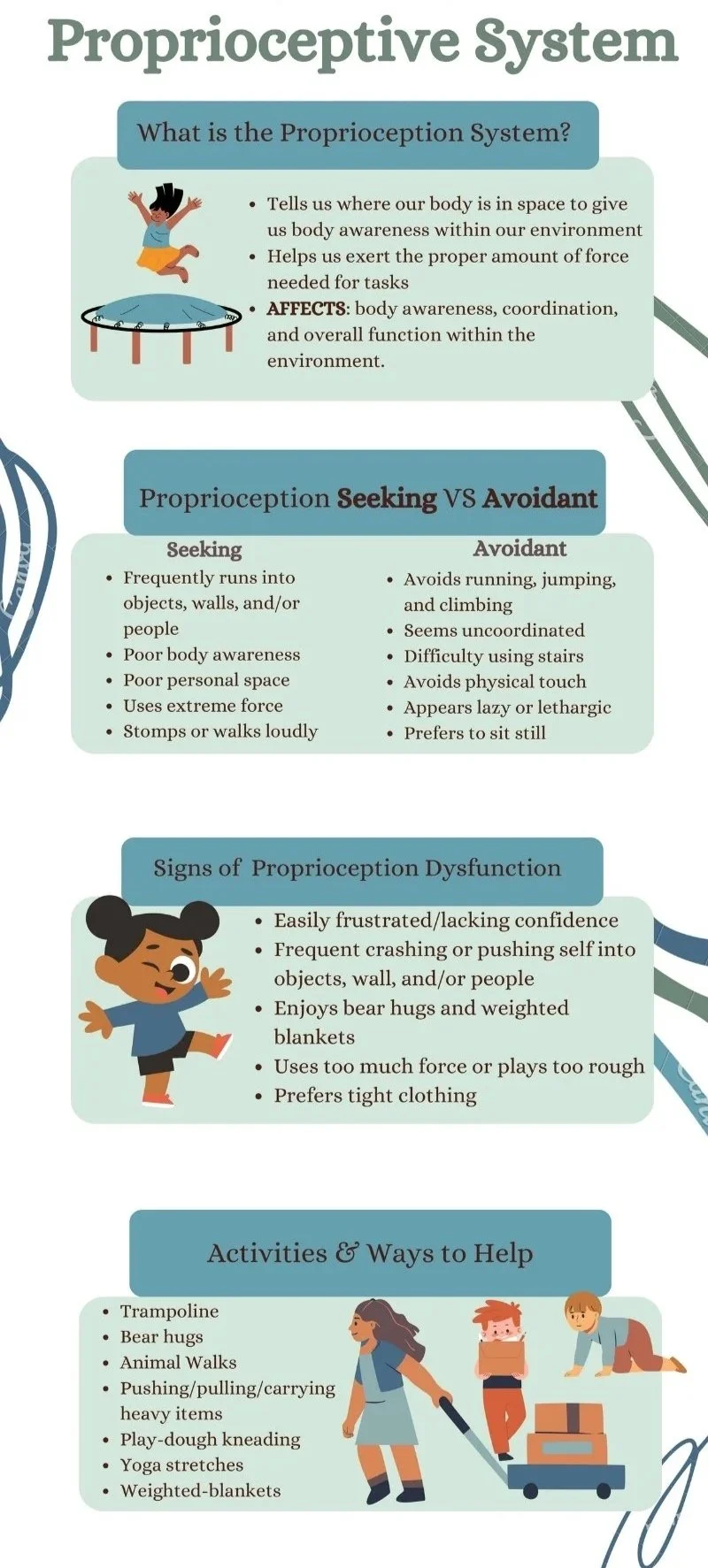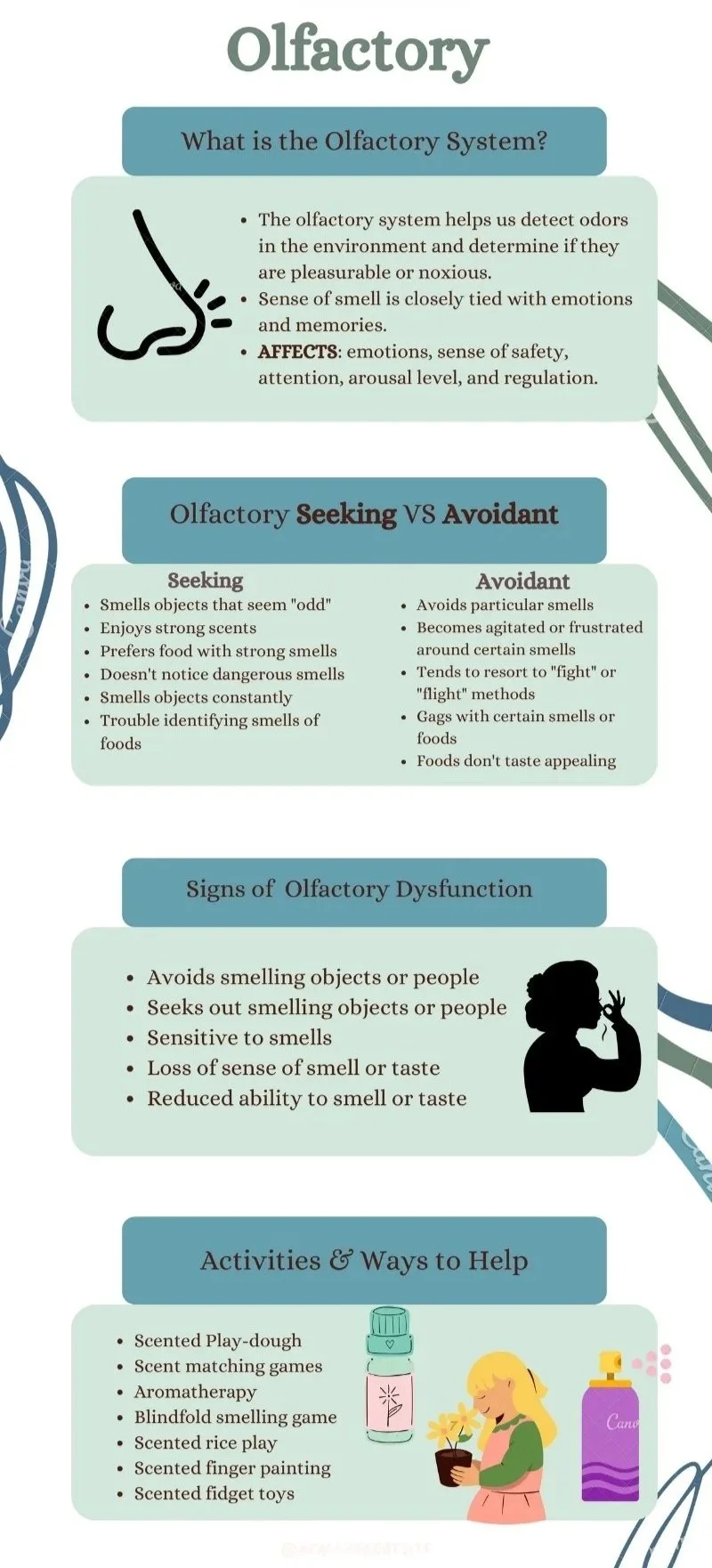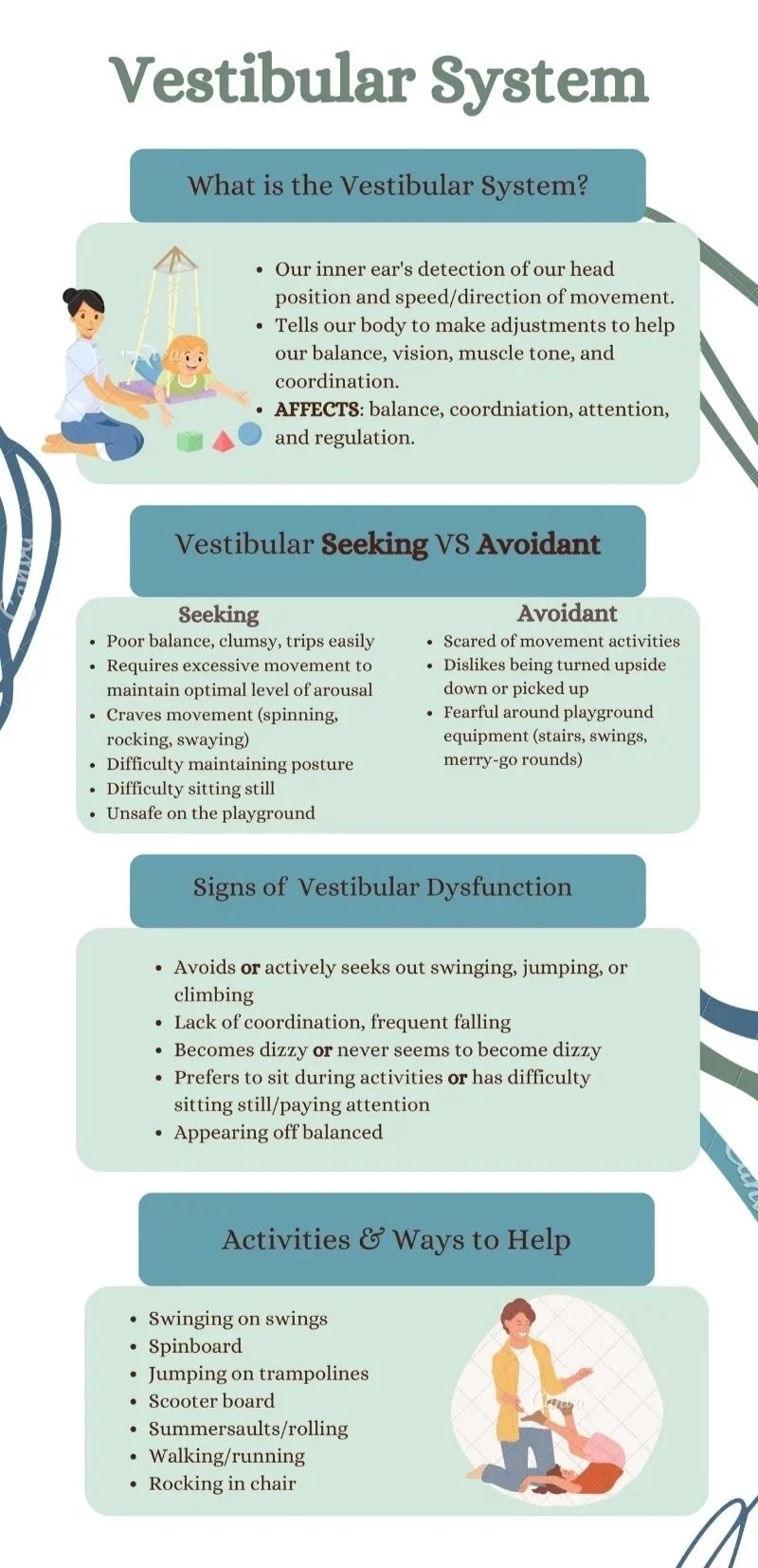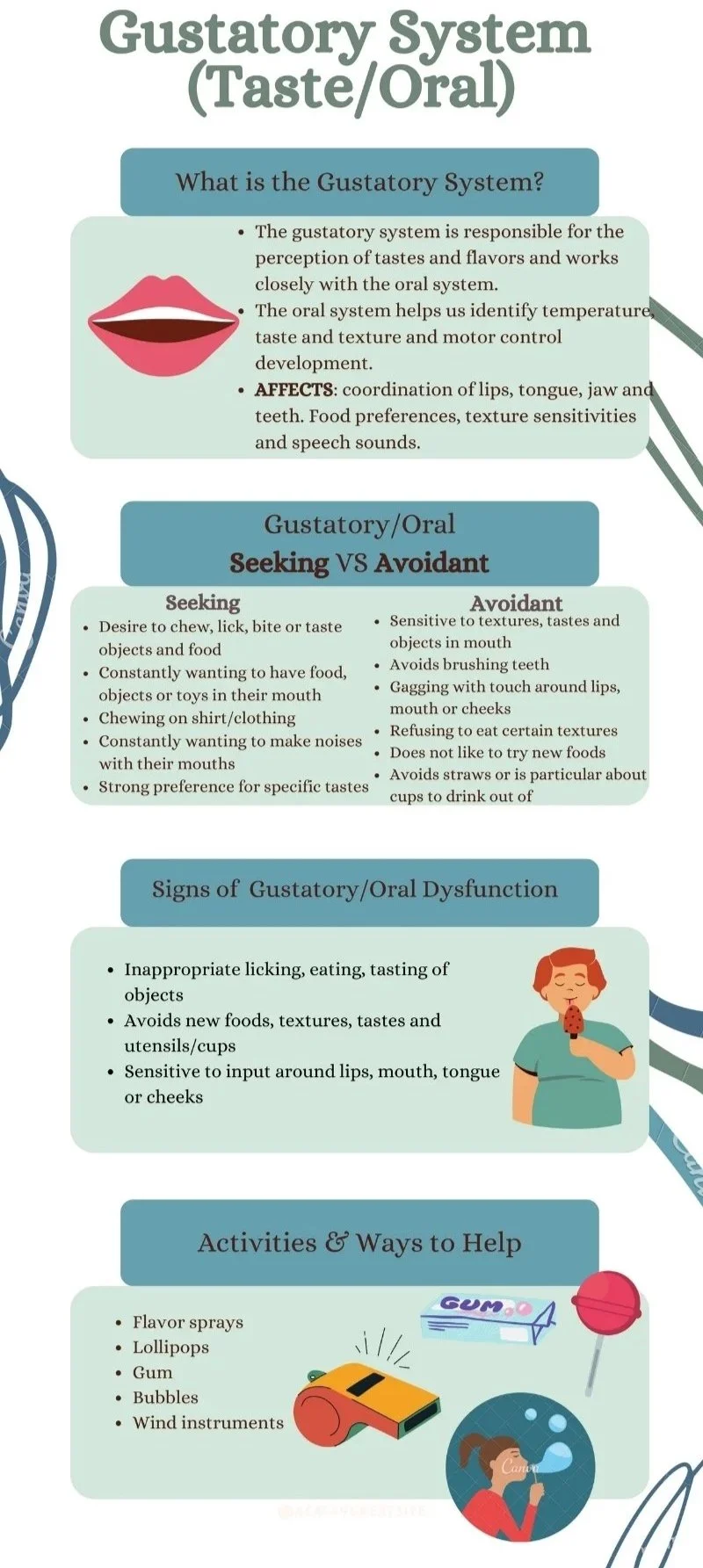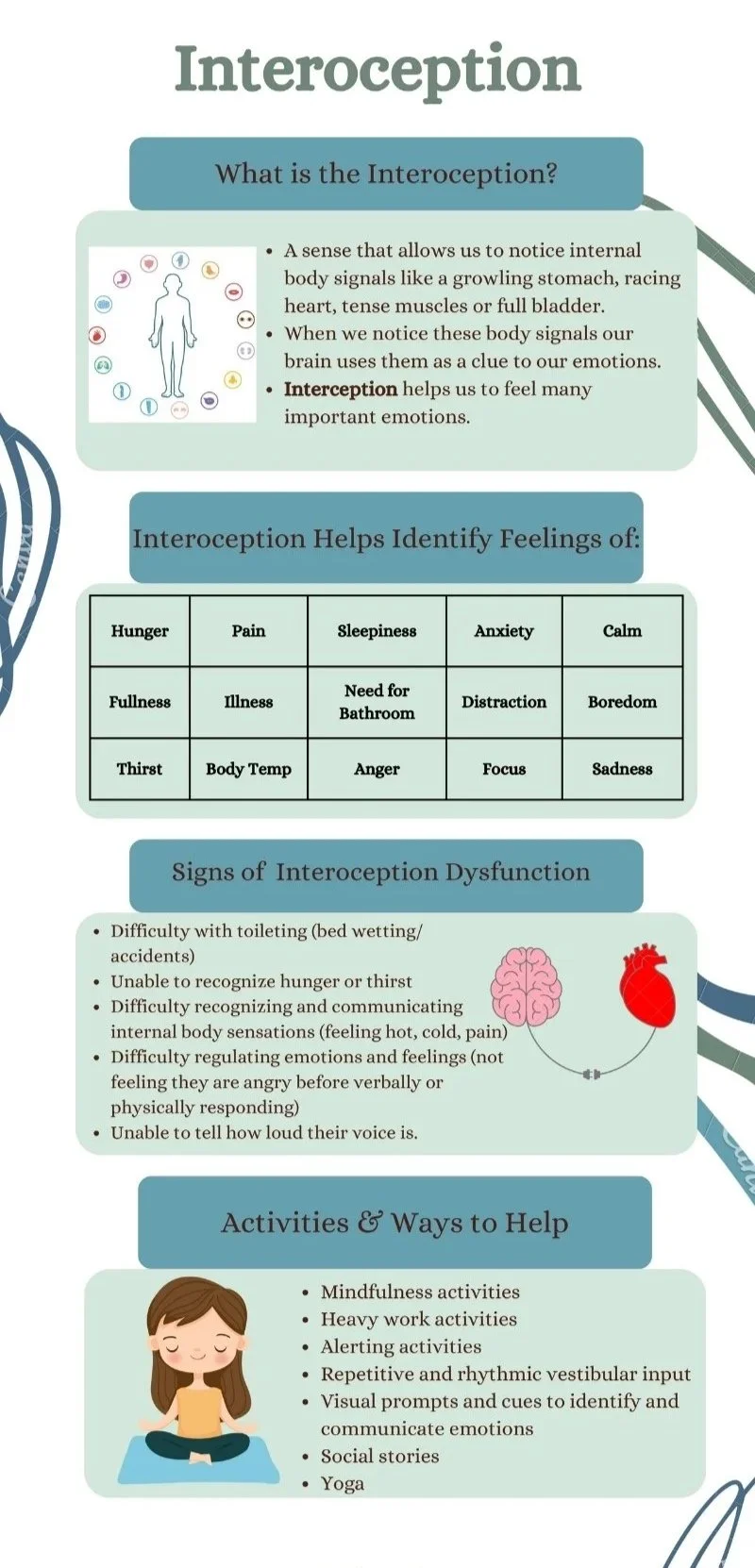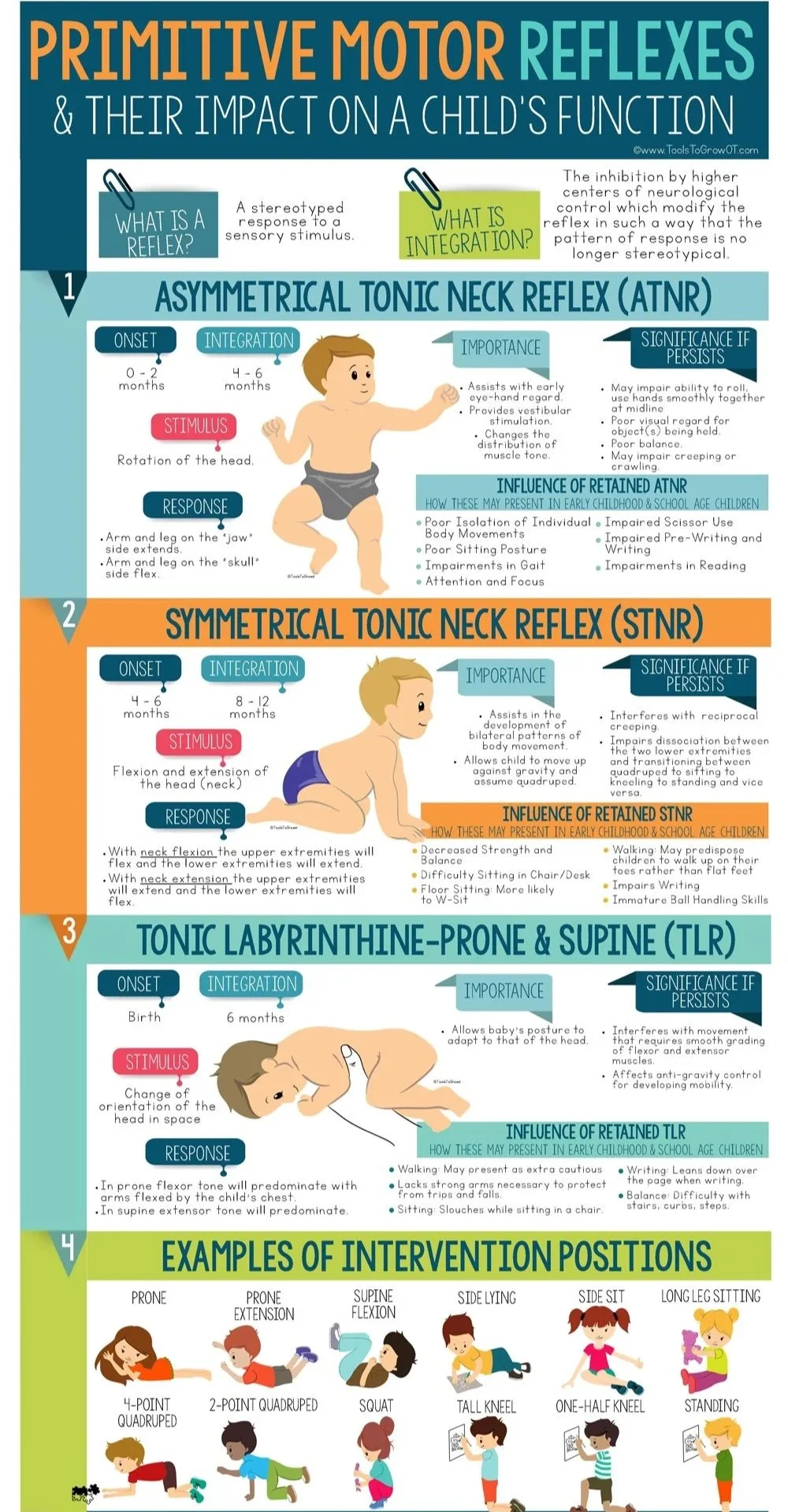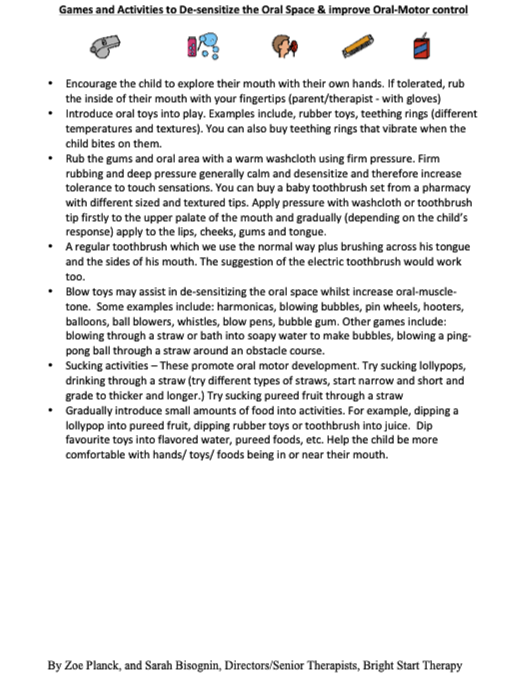Parent Resources📃
Understanding the Sensory System
Our sensory system is how we take in and make sense of the world around us — and even what’s happening inside our own bodies. Most people know the five main senses: sight (vision), hearing (auditory), smell (olfactory), taste (gustatory), and touch (tactile). But there are also three “hidden” senses that are just as important. Proprioception helps us know where our body is in space and how hard to push, pull, or move. Vestibular input helps us balance and understand movement and direction. Interoception is our internal sense — it helps us notice and respond to signals like hunger, thirst, temperature, or the need to use the bathroom. Together, these eight senses help children explore, learn, and feel comfortable in their world. When one or more of these systems is over- or under-responsive, it can affect attention, behavior, and daily participation — and that’s where we can provide valuable support.
Understanding Primitive Reflexes
Primitive reflexes are automatic movement patterns babies are born with that support survival and early development. Common reflexes include the Moro (startle), Rooting, Palmar Grasp, Asymmetrical Tonic Neck Reflex (ATNR), Symmetrical Tonic Neck Reflex (STNR), Tonic Labyrinthine Reflex (TLR), and Spinal Galant (Galant) reflex. These reflexes help build the foundation for posture, coordination, and motor control in the first months of life. As a child’s brain and nervous system mature, these reflexes typically “integrate,” or fade away, allowing for more controlled and intentional movement. When primitive reflexes remain active beyond infancy, they can affect a child’s ability to focus, move efficiently, or participate fully in daily tasks. Occupational and physical therapists can help identify and integrate retained reflexes through movement and play-based activities that support development and regulation.
Additional Information: integratingreflexes.com
Understanding Sensory Processing Disorder (SPD)
Sensory Processing Disorder (SPD) refers to challenges in how the brain receives, organizes, and responds to sensory information. Children with SPD may have difficulty interpreting input from their senses, which can affect how they move, play, learn, and interact with the world around them. SPD is generally grouped into three main subtypes:
Sensory Modulation Disorder (SMD) - a problem with turning sensory messages into controlled behaviors that match the nature and intensity of the sensory information.
Sensory Over-Responsivity (SOR) - respond to sensory messages more intensely, more quickly, and/or for a longer period of time.
Sensory Under-Responsivity (SUR) - exhibits less of a response to sensory information that the situation demands, taking longer to react and/or requiring intense or long lasting sensory messages before they are moved to action.
Sensory Seeking (SS) - have a nearly insatiable craving for sensory experiences and actively seek sensation, often in ways that are socially unacceptable. Frequently over active and appear to have limited ability to control their impulses.
Sensory-Based Motor Disorder (SDMD) - a problem with stabilizing, moving, or planning a series of movements in response to sensory demands.
Dyspraxia - difficulty translating sensory information into physical movements, unfamiliar movements, or movements with multiple steps. Can affect gross motor, fine motor, or oral motor skills:
- Gross Motor - often awkward and clumsy. Late to reach motor milestones such as crawling and walking. Struggles with playground games, sports, and riding a bike. Lack a natural sense of where their bodies are in space or in relationship to objects and other people. They trip and bump into things frequently.
- Fine Motor - difficulties reaching for objects, holding small objects, and/or letting go of objects when they want to. Trouble coloring inside the lines, handwriting is nearly impossible to read. Can struggle with self-care activities such as dressing, combing their hair and bathing. Have difficulty managing clothing. Children with dyspraxia may have messy handwriting because they can’t plan where to put the letter on the page, how big it should be, or how much space should appear between one letter and the next. May also use a combination of upper and lowercase letters in the same word.
- Oral Motor - challenges involving the mouth, lips, and tongue. May have difficulty with such, swallow, breathe. Trouble with chewing and eating. May also keep mouth open, causing drooling. Can also affect speech making it hard to coordinate their lips and tongue to form words. Children with dyspraxia often have a low tolerance for frustration and may suffer low self esteem because of their chronic failure to perform basic motor activities. Social rejection is common because of symptoms such as drooling, dishevelment, or being a “klutz.”
- Postural Disorder - difficulty maintaining enough control of their bodies to meet the demands of a given motor task. Frequently have low muscle tone, difficulty crossing midline, poor balance, does not consistently use dominant hand, has poor endurance and tires easily. Children with Postural Disorder may have messy writing because they lack the muscle tone in their shoulders and upper bodies to stabilize themselves in an upright position while their fingers keep a just-right grip on the pencil.
Sensory Discrimination Disorder (SDD) - a problem with sensing similarities and differences between sensation. Inability to interpret and distinguish messages within the sensory systems:
Tactile - impairment in the ability to feel light touch, pressure, temperature, pain, and vibration. May affect the ability to correctly identify familiar items by touch alone, to identify where a tactile message is coming from or to distinguish temperature.
Vision - impairment in the ability to interpret what is seen. May affect the ability to correctly identify shapes and forms, match visual elements, remember visual information, or recognizing objects that are partially concealed.
Auditory - impairment in the ability to process or interpret sounds. May affect the ability to correctly discern the source or location of sound, distinguish selected sounds from background noise, distinguish similar sounds, identify sound, or remember sounds when they are incomplete.
Taste/Smell - impairment in differentiating textures/tastes of food and smells.
Vestibular - impairment in the ability to feel movement of the head and body in relation to the earth’s gravity.
Proprioceptive - impairment in the ability to feel the amount of sensory input to joints and muscles.
Understanding Social Skills Development
Social skills help children build relationships, communicate effectively, and navigate everyday interactions with confidence. These skills include sharing, taking turns, understanding emotions, reading social cues, and problem-solving with peers. Some children may find social interactions challenging due to differences in communication styles, sensory processing, emotional regulation, or developmental factors. Occupational and physical therapists can support social growth by using play-based activities, group interactions, and emotional regulation strategies that help children connect, cooperate, and communicate more successfully. By strengthening these skills, we help children develop meaningful relationships and thrive in their home, school, and community environments.
Resources we love:
Autism Teaching Strategies by Joel Shaul: Free social skills downloads
Handy Handouts for Parents: Free educational handouts for parents to use to teach social skills.
Pathway 2 Success: Free social emotional learning resources.
PBIS World: List of social skills plus resources to teach for elementary and middle school.
Scholastic for Parents: Social Skills Grade by Grade: Topics that are defined and suggestions provided on how to teach for each grade level.
Silas: Improve Life Outcomes: Free social animations, social-emotional learning lessons, and parent sheets for use at home.
Understanding Feeding Difficulties
Feeding is a complex skill that involves the coordination of sensory processing, motor control, and emotional regulation. Some children may experience challenges with eating such as picky eating, food refusal, limited diets, gagging, or difficulty chewing and swallowing. These difficulties can stem from a variety of factors, including oral motor weakness, sensory sensitivities to taste or texture, or negative mealtime experiences. Occupational and physical therapists trained in feeding therapy use a gentle, play-based approach to make mealtimes more positive and successful. By addressing the underlying sensory and motor skills needed for eating, therapy helps children explore new foods, develop safe feeding patterns, and build confidence at the table.
Our favorite handouts:

